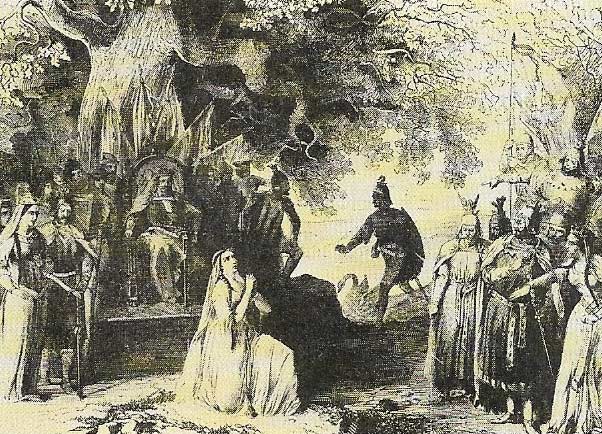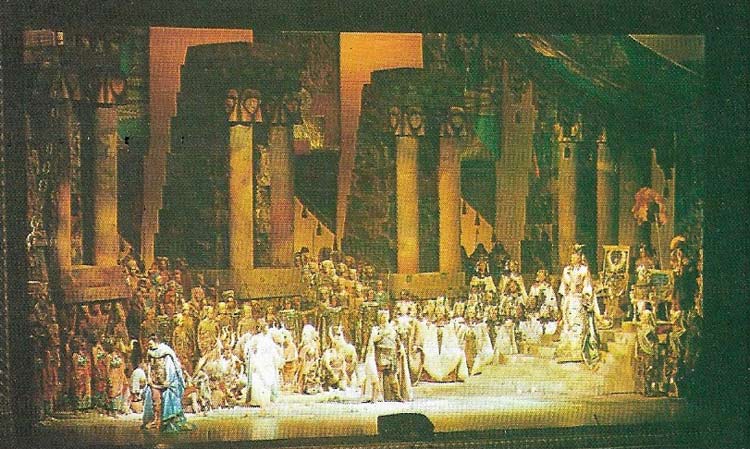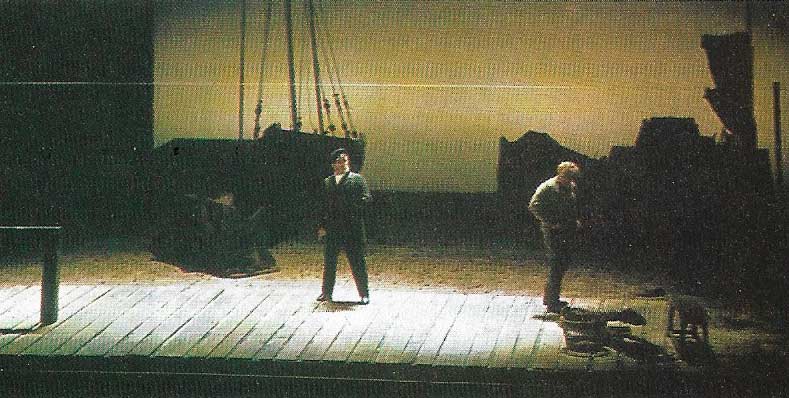opera in the 19th and 20th centuries

Figure 1. The casting of the magic bullets in the Wolf's Glen is the most famous scene from Carl Maria von Weber's Der Freischütz. The opera, literally "The Freeshooter", meaning a marksman who uses magic bullets, is regarded as a pioneer work of the Romantic era, and is notable for Weber's orchestral effects, particularly during the sinister action in the scene depicted. In Der Freischutz Weber reinforced the line of German opera leading from Mozart to Wagner.

Figure 2. The knight Lohengrin arrives in a boat by a swan in a scene from the first production of Lohengrin by Richard Wagner, given at Weimar in 1850 under Franz Liszt. Lohengrin represents a mid-point in the development of Wagner's music; it is the last in a series of operas with traditional elements from grand opera and set-piece numbers. His later operas – Tristan and Isolde, The Mastersingers, The Ring of the Nibelung cycle, and Parsifal – would exemplify his ideas of opera as a continuous music-drama of endless melody, bound together by musical motifs representing characters, objects, and ideas.

Figure 3. The Barber of Seville is the best-known comic opera by Gioacchino Rossini, whose music dominated the world of opera in the early 19th century. In this characteristic scene from Act ll the cheerful Barber Figaro shaves the pompous old Dr Bartolo, who mistakenly believes he will marry the heroine Rosina, while Figaro is scheming another husband for her.

Figure 3. Aida, by Giuseppe Verdi (in production at the Royal Opera House, Covent Garden), represents the full flowering of Italian opera in the 19th century, with its spectacle, colour, dramatic love triangle and tragic ending, all enriched by Verdi's dramatically apt music. The opera was commissioned as a festival work by the Khedive of Egypt to celebrate the opening of the Suez Canal, and first performed in Cairo in 1871. Set in ancient Egypt, the story tells of the Ethiopian slave girl Aida and her love for the Egyptian army officer Radames, who is tricked by her into betraying his country.

Figure 4. The Dresden Hoftheater (opera house) was designed and built between 1871 and 1878 to replace an earlier building that had been destroyed. Many European opera houses built or rebuilt in the 18th and 19th centuries (La Scala, Milan, 1778; Royal Opera House, Covent Garden, 1856) were modelled on the old Italian plan of tiers of boxes placed around the auditorium.

Figure 5. Wagner was never loath to draw attention to himself, as this contemporary French caricature of a performance of one of his operas in the composer's presence clearly indicates. Paradoxically, while he may have worn red velvet and called himself the apostle of a new religion (his music), he was the first to insist on dimming the lights and making late-comers wait so as not to disturb the audience. His opera house at Bayreuth remains a model of theater planning.

Figure 6. Peter Grimes, by Benjamin Britten, scored a resounding success throughout Europe and America from its first performance in 1945, and started a new interest in British opera. Based on a poem by George Crabbe, its central character is the fisherman Peter Grimes, seen here with Balstrode, a retired skipper. Grimes is an alienated figure in his own community, and the situation is clearly reflected in Britten's spare yet attractively lyrical music
About the turn of the 19th century the growth of a middle-class concert-going audience encouraged the practice of giving performances in public opera houses. The resulting demand for new repertory allowed many composers to specialize in opera for the first time and the public welcomed entertainment that was in many ways more attractive than the lavish court spectacles.
Serious and comic opera
The traditional streams of serious opera and comic opera remained distinct, but both were at that time seen regularly at the opera house. The naturally dramatic character of the form also began to reflect the political and social situations, however disguised, in which it was produced – Risorgimento or the hoped-for reunification of Italy in the works of Giuseppe Verdi (1813–1901), the national traditions in the Russian operas of Modest Mussorgsky (1839–1881) and Mikhail Glinka (1804–1857), or in the works of the Bohemian Bedrich Smetana (1824-84). Eventually a more realistic approach appeared in the versmo (realistic) operas of Pietro Mascagni (1863–1945), Ruggiero Leoncavallo (1858–1919), and Giacomo Puccini (1858–1924) later in the century.
When in 1791, the last year of his life, Wolfgang Amadeus Mozart (1756–1791) composed a serious opera in Italian, La Clemenza di Tito, and a comic opera or Singspiel in German, The Magic Flute, it was the latter, using elements of mystery and folk-like humor as well as the vernacular, which foreshadowed later developments in German opera with its concern for unity of music and drama. Ludwig van Beethoven (1770–1827) in his single opera Fidelio (1805) made a rather earnest German contribution; but it remained for the deft touch of Weber (1786–1826) in Der Freischütz (Fig 1)and Euryanthe to shape the inheritance that Wagner would take up (Figure 2).
The influence of Rossini
This young German growth among the diverse branches of opera would have to struggle against the traditional dominance of the Italians and in particular against the prevailing fashion for the music of Gioacchino Rossini (1792–1868) which had swept through the opera houses of Europe in the early part of the century. The Barber of Seville (Figure 3), The Italian Girl in Algiers, and Cinderella among his many comic operas demonstrate the exciting Rossini crescendo in the orchestral writing and brilliant vocal music that was such a crowd pleaser. The legendary virtuoso singers of the time, such as Maria Malibran, Luigi Lablanche, and Giovanni Grisi, encouraged the musicians who followed Rossini, such as Vincenzo Bellini (1801–1835) and Gaetano Donizetti (1797–1848), to compose in the same vein. Bellini was more Romantic in La Sonnambula and Norma.
Grand opera and after
While the comic opera tradition in France was greatly weighed down under Rossini's influence, grand opera tradition found expression from 1830 onwards in the works of Giocomo Meyerbeer (1791–1864). In reaction to the eventual bombast of his Les Huguenots and Le Prophète, a lyric opera style emerged in the 1850s, represented by Charles Gounod (1818–1893) and Jules Massenet (1842–1912). Hector Berlioz (1803–1869) was simultaneously pursuing and independent course.
Meanwhile in Italy, Verdi (Figure 4) had Nabucco – his first major work - performed in 1842, and became identified with the cause of a united Italy. His operas began to show at the same time an emotional power and psychological insight that were to culminate in the magnificent dramas of Rigoletto, Il Trovatore, La Traviata and many others. His last two operas, Otello and Falstaff, emphasize continuity in the music rather than individual arias, a style that Richard Wagner (1813–1883) had developed independently in Germany in his music-dramas.
 |
| Adelina Patti (1843–1919), the celebrated Madrid-born coloratura soprano, here in the role of Marguerite in Gounod's Faust, enjoyed an operatic career that spanned nearly 60 years. Patti was acclaimed as the last in a great line of prima donnas who were typical of 19th-century opera. She was noted as Rosina in The Barber of Seville, and Rossini himself arranged music for her. |
 |
| Fyodor Chaliapin (1873–1938), the great Russian bass, gained world fame in the title role of Mussorgsky's Boris Godunov, which he was the first to preform outside Russia. His strong acting performances and resonant voice brought him world premiere roles in Massenet's Don Quichotte and Mussorgsky's Khovantchina. His New York success in the 1920s made him as admired as Caruso. |
In Russia, the early emphasis on nationalist opera begun by Glinka now flowered in the works of Alexander Borodin (1834–1887) Nikolai Rimsky-Korsakov (1844–1908), Mussorgsky, and Peter Ilyich Tchaikovsky (1840–1893) who wrote ten operas. Carmen, by the French composer Georges Bizet (1838–1875), was another key work, beginning the trend of realism in operas. At the same time, another Frenchman, Claude Debussy (1862–1918), in his single operatic work Pelléas and Melisande reacted against Wagnerian opera.
 |
| Lulu by Alban Berg (1885–1935) is one of the major operatic works of the 20th century. It tells the story of Lulu, a prostitute who ends up as one of Jack the Ripper's victims in a London street. Written in the 12-tone harmony developed by Arnold Schoenberg (1874–1951), Berg's teacher, Lulu was unfinished at Bergs's death, with only two out of three acts published; it was performed like that two years later. The opera continues Berg's concern for human beings as victims of persecution – a theme that he first explored in Wozzeck, the study of an anti-hero – and is dramatically suited by the often harsh music. |
After Debussy the 20th century was to see a wide range of operatic techniques and styles. With the dispersing on the Italian monopoly, operas were to appear in all languages: some, such as those of Richard Strauss (1864–1949), Leos Janacek (1854–1928). and Sergi Prokofiev (1891–1953), followed national trends; others even delved back into the classics, as did Igor Stravinsky (1882–1971) for his opera-oratorio Oedipus Rex in Latin. Presentation ranged from the simple – two characters in Bluebeard's Castle by Bela Bartók (1881–1945) – to the representation of a city in the satirical Mahagonny by Kurt Weill (1900–1950). Benjamin Britten (1913–1976) made his mark as an opera composer of the highest international status with his Peter Grimes (Fig 6). After some years of composing chamber operas, Britten returned to large-scale works with Billy Budd (1951), and Gloriana (1953) written for Elizabeth II's coronation.
